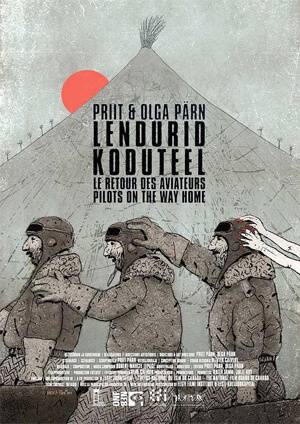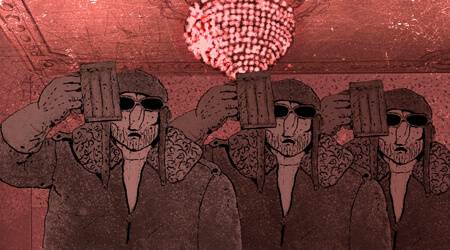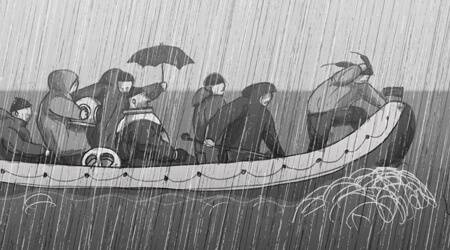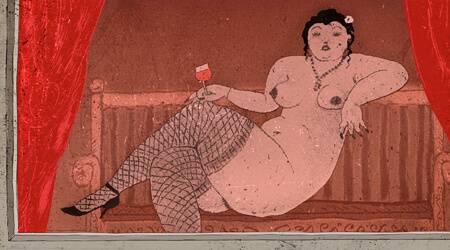An Interview with Priit Pärn
 Undoubtedly one of Eastern Europe’s most commendable animation artists, Priit Pärn is still producing adventurous and daring work well into the fourth decade of his career. In the past Pärn has achieved notoriety with such films as Hotel E (1992), Breakfast on the Grass (1987), 1895 (1995) and Night of the Carrots (1998). With a deft ability to retain a core style whilst combining approaches to design and technique, his choice of subject matter is often provocative with a frequently witty, absurdist and, at times, scathing take on life, politics, technology and sexuality. The latter certainly comes into play with his sixteenth major short film project Pilots on the Way Home, the latest of several (including the acclaimed Divers in the Rain in 2010) for which he has shared directorial duties with his wife Olga, herself an accomplished Art Director. This latest film, combining sand and hand-drawn animation, is also the pair’s first co-production with the National Film Board of Canada, telling the story of three pilots traversing a vast desert, the lines between fantasy and reality ever devolving throughout their journey until it reaches a frenetic and concupiscent end. Premiering on the festival circuit last year, Pilots has quickly earned itself a reputation as being amongst the duo’s finest works, topping critics’ lists and earning an Estonian Cultural Endowment Award for Best Film of 2014. We spoke to Priit at the 2014 Annecy Festival where the film premiered to get his take on the animation process, developing stories and collaboration.
Undoubtedly one of Eastern Europe’s most commendable animation artists, Priit Pärn is still producing adventurous and daring work well into the fourth decade of his career. In the past Pärn has achieved notoriety with such films as Hotel E (1992), Breakfast on the Grass (1987), 1895 (1995) and Night of the Carrots (1998). With a deft ability to retain a core style whilst combining approaches to design and technique, his choice of subject matter is often provocative with a frequently witty, absurdist and, at times, scathing take on life, politics, technology and sexuality. The latter certainly comes into play with his sixteenth major short film project Pilots on the Way Home, the latest of several (including the acclaimed Divers in the Rain in 2010) for which he has shared directorial duties with his wife Olga, herself an accomplished Art Director. This latest film, combining sand and hand-drawn animation, is also the pair’s first co-production with the National Film Board of Canada, telling the story of three pilots traversing a vast desert, the lines between fantasy and reality ever devolving throughout their journey until it reaches a frenetic and concupiscent end. Premiering on the festival circuit last year, Pilots has quickly earned itself a reputation as being amongst the duo’s finest works, topping critics’ lists and earning an Estonian Cultural Endowment Award for Best Film of 2014. We spoke to Priit at the 2014 Annecy Festival where the film premiered to get his take on the animation process, developing stories and collaboration.
What was your background before moving into animated films?
I was educated as a biologist, but as for my artistic background I started with drawing caricatures for magazines. I did this before, during and after university, then spent six years in professional life. Then, around ’73-’74, I made some character designs for an animated film (Rein Raamat’s Kilplased), and in ’76 the studio (Joonisfilm, formerly Tallinnfilm) invited me to be a director. So I made my decision from that point on and now here I am.
What early influences helped you to develop your style initially?
I had inspirational idols in the world of caricature. In the beginning I was very bad at drawing and had to seek advice – I didn’t know how to draw mouths for example! You can feel moments of imitation . There have been many influences for me, such as the Czechoslovakian style, and early on you could see moments of imitation, but by the time I went into animation when I was thirty I was personally ready and knew exactly what I wanted to do. Of course I have filmmakers whose films I like, but stylistically they are quite different from me, so maybe it was good from the very beginning to go down my own road.

Pilots on the Way Home
You also teach animation, what do you enjoy most about that process?
I think that the good thing about teaching is that it’s keeping me sharp. My brain has to be faster than my students’ brains. so if I have creative projects at the same time and they’re showing me this it’s something for my brain. Teaching is practical next to having an income as a freelancer, either as a graphic artist or animated filmmaker, especially for long breaks between films. I think I have developed a good system of how to teach but sometimes I have to tell myself to stop and go back to making films.
Of your films to date are there any you hold particularly close to your heart?
Of my own films there’s Life Without Gabriella Ferri (2008) or 1895 (1995). Pilots on the Way Home is still very new but I think it may become my favourite.
Is Pilots your first collaboration with the NFB to date or had you worked together before?
No, it was the first time.
How did you find that pairing?
I think it was the right decision to collaborate with them, because they respect my work. They’re professionals, the sound designers and my editor both achieved a really good result. I think they have a good team to promote the film when it is done, pushing it around the world to festivals. One reason to collaborate with them is, because we have such a small studio in Estonia (where, up to now, the financing of animation production is quite good, though who knows what will happen tomorrow?) when a film is done then what to do with it is mainly the director’s problem. We don’t have special people like a team for distribution, festivals and so on. So I think that it was a good decision to make it with them.
And I believe this is the third film you co-directed with Olga?
No, the fourth – the first was I Feel a Lifelong Bullet in the Back of my Head (2007) then Life Without Gabriella Ferri, then Divers in the Rain (2010) and now Pilots on the Way Home, so in eight years we made ninety minutes of animation, which is a lot. For some animators it’s like their life’s work!

Divers in the Rain
When and how did you realise that you worked together well as filmmakers?
Olga is actually from Byelorussia but she studied in France, after which we decided we would live together in Estonia. Working together was a very practical matter, she moved there to work on this two minute film (Bullet) based on the work of Estonian poet Jüri Üdi. At first I didn’t wish to take part in that culture but it was an opportunity to bring Olga to Estonia. This film was just the start, we moved on to bigger projects. On Life Without Gabriella Ferri we found that we worked well together as a team.
Can you describe what roles you each take on with the films?
Basically I’ll write the script and of course we’ll discuss details and so on. On Divers we worked with a studio of animators, in-betweeners, clean-up people, but this latest film we worked together, trying to figure out what worked best. From the 80s to the beginning of the nineties I did a lot of etching, and Olga graduated from the Byelorussian Academy of Art in 2000 where she specialised in etching also. When we saw what one another did it was, in a way, aesthetically similar, so we don’t fight over artistic direction. There isn’t always a clear picture to begin with but, moving step by step, the road gets narrower until yes, there it is. It’s a collective work. Olga is very good with computers so I mainly keep to the hand-made part – character design, line drawings, storyboards – and then she works on the final visuals with software. Editing we do together, she has a very good sense of timing and dealing with sound so it’s a really good team
What often happens is that people who are the same age will come out of art school, have the same profession and live together, then one day one is more successful than the other and end up fighting because one has to wash dishes while the other paints, for example. We don’t have these problems, every single project I’ve had she’s been involved in some way, and before we started to work together she had her own films. There’s no tension, nobody dominates, the real result is of teamwork.

Pilots on the Way Home
Can you discuss a bit about the story and meaning of Pilots?
“What is the meaning of life?” (Laughs) No, I think maybe it’s the kind of story you can only make in animation. With some of my films, maybe Gabriella, you’d need to change some things but it’d be possible to make it in live-action based on the same script. With Pilots there’d be no way to do that. It’s a very simple story, if you asked how long I wrote the script I’d say maybe it was 15 seconds? I had the picture in my mind of three pilots carrying suitcases containing three parts of the female body. I saw this picture but had been looking for a story. I’d started a sand animation where the story was completely different and not interesting for me, but when I saw this picture it was immediately in my head. Of course then you need to work with details – why is this happening? Where are they going? What is in the suitcases? These kinds of things you can only do in animation, it’s the beauty of animation that you can give things more of a double meaning. If somebody wishes to take the film literally, then why not? It’s what they decide to do. But if I insist “No, no – it’s dreams and desires and memories…” then I destroy this possibility of double meaning. I don’t have expectations of how the audiences will take the film, so I try to avoid synopses and not talk about what is in the suitcases, to take the audience by surprise and give them the right to make their own decision as to what it is. Of course it seems that in the end there are no suitcases, you make your own ending. I will say that the ‘erotic’ sequences are unique, probably disturbing for some people, but I think it’s good to provoke because animation isn’t always for children.
What do you have planned next?
It was such a tough project – the work we had to prepare, all the advertising materials and so on – that we’re taking a break from filmmaking. It’s best when you don’t plan what you do and just let it come to you. You play with some images, some sequences of story, then things get interesting.
You can also read about Priit Pärn’s classic 1987 short Breakfast on the Grass as part of Stephen Cavalier‘s 100 Greatest Animated Shorts series. To learn more about Eesti Joonisfilm and the films of Priit and Olga Pärn visit joonisfilm.ee
You can explore the work of the National Film Board of Canada at nfb.ca

